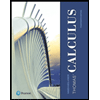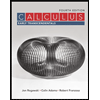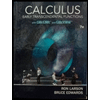
Concept explainers
To verify: The functions f and g are inverses by showing f(g(x))=x , and g(f(x))=x .
Given data: The functions f(x) and g(x) are; f(x)=3x−2 and g(x)=x+23 .
Method/Formula used:
The composite functions of two functions f(x) and g(x) are denoted by (fοg)(x) and (gοf)(x) given by (fοg)(x)=f(g(x)) , and (gοf)(x)=g(f(x)) .
Verification:
The given functions are; f(x)=3x−2 and g(x)=x+23 . Therefore,
f(g(x))=f(g(x)) ←substitute(x+23)for g(x)=f(x+23) ←use definition of f(x)=3x−2=3(x+23)−2 ←simplify=x+2−2 =x
Further,
g(f(x))=g(f(x)) ←substitute(3x−2)for f(x)=g(3x−2) ←use definition of g(x)=x+23=(3x−2)+23 ←simplify=3x−2+23 =x
Now, f(g(x))=x⇒ g=f−1(x) , i.e., the function g is the inverse of function f .
Also, g(f(x))=x⇒f=g−1(x) , i.e., the function f is the inverse of function g .
That shows the function f and g are inverses.
Chapter 1 Solutions
PRECALCULUS:...COMMON CORE ED.-W/ACCESS
- quick solve thisarrow_forwardquick solve thisarrow_forwardThis table displays the current in equal intervals. Time t/ms 05 10 15 20 25 30 Current i/A 0 4.8 9.1 12.7 8.8 3.5 0 The formula for the charge as follows: 30x10-3 q 0 i dt Use formula to solve the current at 30ms using both the trapezoidal rule and Simpson's rule showing all steps and workingarrow_forward
 Calculus: Early TranscendentalsCalculusISBN:9781285741550Author:James StewartPublisher:Cengage Learning
Calculus: Early TranscendentalsCalculusISBN:9781285741550Author:James StewartPublisher:Cengage Learning Thomas' Calculus (14th Edition)CalculusISBN:9780134438986Author:Joel R. Hass, Christopher E. Heil, Maurice D. WeirPublisher:PEARSON
Thomas' Calculus (14th Edition)CalculusISBN:9780134438986Author:Joel R. Hass, Christopher E. Heil, Maurice D. WeirPublisher:PEARSON Calculus: Early Transcendentals (3rd Edition)CalculusISBN:9780134763644Author:William L. Briggs, Lyle Cochran, Bernard Gillett, Eric SchulzPublisher:PEARSON
Calculus: Early Transcendentals (3rd Edition)CalculusISBN:9780134763644Author:William L. Briggs, Lyle Cochran, Bernard Gillett, Eric SchulzPublisher:PEARSON Calculus: Early TranscendentalsCalculusISBN:9781319050740Author:Jon Rogawski, Colin Adams, Robert FranzosaPublisher:W. H. Freeman
Calculus: Early TranscendentalsCalculusISBN:9781319050740Author:Jon Rogawski, Colin Adams, Robert FranzosaPublisher:W. H. Freeman
 Calculus: Early Transcendental FunctionsCalculusISBN:9781337552516Author:Ron Larson, Bruce H. EdwardsPublisher:Cengage Learning
Calculus: Early Transcendental FunctionsCalculusISBN:9781337552516Author:Ron Larson, Bruce H. EdwardsPublisher:Cengage Learning





